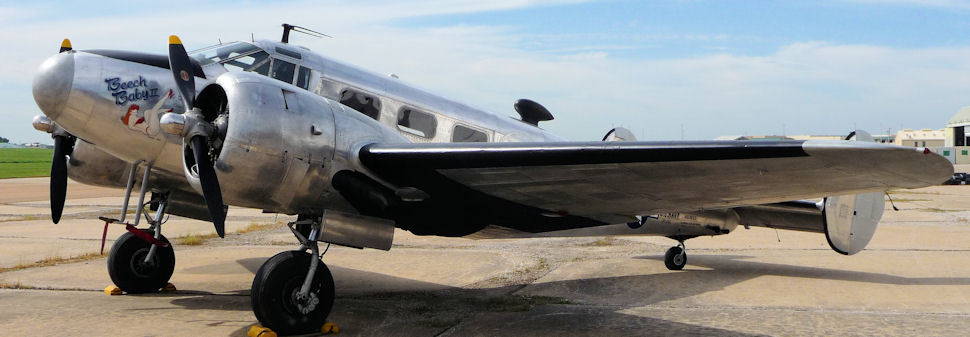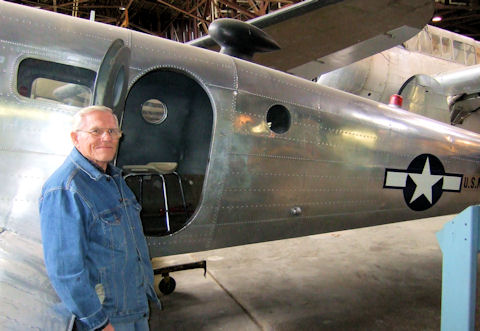The Model 18 was one of Beech Aircraft’s most successful and longest running production designs. It was in production from 1937 until November 26, 1969. Some 18 commercial variants were built. The Model 18 was designed for private and civil aviation, combining low operating costs, cabin comfort, and safety features comparable to those found on commercial airliners. The aircraft was designed to operate from small airfields and have a high degree of reliability and ease of repair. The first flight took place on January 15, 1937. Beech employees dubbed the Model 18 the Twin Beech. The design faced stiff competition from Lockheed’s Electra Junior in the late 1930’s, but after the United States’ entry into World War II production soared in order to meet the needs of the US military for trainers and utility transports. All branches of service flew versions of the Twin Beech, and this continued when the US Air Force came into being in 1947.
Of the nearly 10,000 Model 18s built, over 5,250 were for the US military and were used to train navigators (AT-7/SNB-2), gunners and bombardiers (AT-11/SNB-1), and pilots, and for transporting cargo and personnel (C-45/SNB-5/JRB) and for aerial photography and mapping (F-2). Over 90 percent of US navigators and bombardiers in World War II trained in versions of the Twin Beech. Navigator, Kansan, and Expeditor were all names used for versions of military Model 18s, but the most commonly used name was Twin Beech. The US military flew a dozen basic variants, with nearly 40 sub-variants. The Army Air Force and Navy (including Marines and Coast Guard) had different designations for the Twin Beech. In September 1962, all surviving military Model 18s became C-45s with different letter suffixes for different versions.
The US Coast Guard stopped flying their JRBs in 1958. The US Air Force retired their C-45s in 1963. The US Navy/Marines retired theirs in 1972, and the US Army ended operations of the C-45 in 1976.
CAM’s Twin Beech is a US Navy SNB-5. Beech Aircraft Company in Wichita, Kansas, originally built the aircraft as an SNB-2 Navigator in 1943. As the name implies, its primary mission was to train aerial navigators, and it also served as a general purpose transport. The US Navy accepted the plane November 5, 1943, with Bureau Number 51241 and took delivery November 10, 1943. The service operated the aircraft for the next 16 years, and it crisscrossed the United States with its various assignments. Beech re-manufactured and converted the aircraft to an SNB-5 transport in 1950-51. It was removed from Naval service in the fall of 1959 but soon started a new year career with the US Department of Agriculture, taking part in the Screwworm Eradication Program along the south Texas-Mexico border. The plane released sterile screwworm flies from a chute installed through the fuselage bottom. History Cards show the aircraft re-designated a TC-45J in September 1962, then an UC-45J in late 1964. In July 1981, the aircraft was registered to Lewis University in Romeoville, Illinois. By 1988, the owner was Courtesy Aircraft, Inc., Rockford, Illinois. CAM purchased 51241 from this corporation on October 12, 1988.
Some initial repair and restoration took place on the Twin Beech during 1989, but it was not until 1992 that a continuous effort to restore the aircraft back to its military likeness began. A core group of four volunteers worked a few days a week for nearly eight years to restore the aircraft to its current configuration.
This aircraft is owned by Combat Air Museum.
| Assignments: |
|
| November 1943: |
Naval Air Intermediate Training, Naval Auxiliary Air Station (NAAS) Rodd Field, (just south of Corpus Christi) Texas
|
| March 1946: |
Naval Air Basic Training, NAAS Corry Field, (just north of Pensacola) Florida
|
| April 1946: |
NAAS Bronson Field, (Perdido Bay) Florida
|
| August 1946: |
VM Unit, NAS Pensacola, Florida
|
| September 1946: |
VM3, Naval Air Basic Training, NAAS Corry Field
|
| December 1946: |
Training Squadron VT-3, NAAS Corry Field
|
| September 1947: |
Training Squadron VT-3, NAAS Whiting Field, (Milton) Florida
|
| October 1947: |
Training Squadron VT-6, NAAS Whiting Field
|
| December 1947: |
NAS Jacksonville, Florida
|
| June 1948: |
NAS Pensacola, Florida
|
| December 1948: |
NAS San Diego, (North Island) California
|
| December 1949: |
11th Naval District, NAS El Centro, California
|
| March 1950: |
11th Naval District, NAS San Diego
|
| August 1950: |
Naval Air Reserve Training, NAS Oakland, California
|
| September 1950: |
Beech Aircraft Company, Wichita, Kansas for rebuild and conversion to SNB-5
|
| April 1951: |
NAS San Diego
|
| April 1951: |
Fleet Air Services Squadron FASRON 691, NAS San Diego. assigned as utility/transports for aircraft carriers when they were in port, including USS PHILIPPINE SEA (CV47), USS BADOENG STRAIT (CVE 116), USS BATAAN (CVL 29), and USS ORISKANY (CV 34)
|
| September 1952: |
USS SHANGRI-LA (CV 38), Boston, Massachusetts
|
| November 1952: |
FASRON 895, NAS Sand Point, (Seattle) Washington
|
| February 1953: |
FASRON 113, NAS Sand Point
|
| August 1953: |
FASRON 113, NAS Whidbey Island, (Oak Harbor) Washington
|
| September 1953: |
NAS San Diego, California
|
| October 1953: |
in storage, Naval Air Facility (NAF), Litchfield Park, Arizona
|
| November 1953: |
NAS Pensacola, Florida
|
| February 1954: |
Advanced Training Unit ATU 801, NAAS Kingsville, Texas
|
| October 1954: |
Naval Auxiliary Air Training Command, NAAS Kingsville
|
| April 1956: |
NAS Pensacola, Florida
|
September 1956: |
Airborne Early Warning Squadron VAW 12, NAS Quonset Point, (east of Shore Acres) Rhode Island
|
| February 1959: |
Fighter Squadron, All Weather, VF(AW) 4, NAS Quonset Point
|
| July 1959: |
In storage NAF Litchfield Park, Arizona,
|
| September 1959: |
US Department of Agriculture, Moore Air Base, Mission, Texas
|
| July 1981: |
Lewis University, Lockport, Illinois
|
| March 1988: |
Courtesy Aircraft, Rockford, Illinois
|
| October 1988: |
Combat Air Museum |
| |
|
| TECHNICAL
NOTES: |
|
| Manufacturer: |
Beech |
| Primary
Use: |
Personnel transport for six to eight passengers
|
| Alternate Uses: |
Trainer
|
| Crew: |
Pilot, co-pilot
|
| Variants: |
C-45H, B-18S
|
| Engines: |
Two 450 hp (335.5kW) each Pratt & Whitney R-985 nine-cylinder, air cooled radial engines
|
| Maximum speed: |
225 mph (362km/h)
|
| Cruising speed: |
129mph (208km/h)
|
| Range: |
1,250 miles (2,012km) |
| Service Ceiling: |
24,900 ft (7,590m) |
| Wingspan: |
47 ft 8 in (14.53m) |
| Wing Area: |
349 sq ft (32.42sq m)
|
| Length: |
34 ft 2 in (10.41m)
|
| Height: |
9 ft 2 in (2.79m)
|
| Weight: |
Empty: 6,000 lbs (2,721.6kg) Gross: 9,300 lbs (4,218.5kg)
|
| Armament: |
None
|
| Serial number: |
US Navy BuNo. 51241 (FAA Reg. Number N87693) |
|






